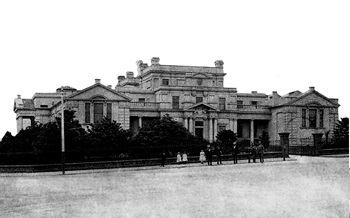2024 | Volume 25 | Issue 5

Albert St front
As many of you may know, the land on which the College head office now stands has a history as rich as the institution itself. Before it became the home of our College, this site was the long-standing location of a school known by many names: the National Model School, Melbourne Common School, Continuation School, and from 1905, Melbourne High School.
This school, established in 1852, is often regarded as the birthplace of universal secular education in Victoria. For decades, it was the heart of the state’s public school system—shaping the future of education in the region. The significance of the site runs deep, which is why, in line with heritage regulations, a thorough archaeological investigation of the site was undertaken under the oversight of Heritage Victoria.
A tumultuous start: the origins of the Model School
The Model School’s story began in 1852, when the land was generously granted by Lieutenant-Governor Charles La Trobe specifically for educational purposes. However, the journey from vision to reality was fraught with challenges. As many men left Melbourne for the goldfields, the city experienced a labour shortage, and the cost of materials skyrocketed.
Despite being designed by one of Melbourne’s most talented architects, A.E. Johnston—who also designed the iconic General Post Office on Elizabeth Street—the construction of the Model School ran into difficulties. Built largely by unskilled labour and using materials sourced from various places, the school quickly earned a reputation for being ‘jerrybuilt’. As a result, it was constantly in need of repair and renovation. One story tells that by the time the school closed in 1927, a council wagon was arriving weekly to remove rotting floorboards and crumbling plaster from the site.
From refurbishment to demolition
When Sir Hugh Devine and the College negotiated with the Argyle government for the site in the early 1930s, there was initial hope that the original school building might be refurbished. However, after a thorough inspection by an architect, the verdict was clear—the building was beyond saving. In 1934, demolition began, and the construction of a new building was set in motion.
Uncovering the past: archaeological excavations
When the archaeological team began their excavation as part of the redevelopment process, they uncovered remnants of the old school, revealing fascinating glimpses into its past. The foundations and basements, which had long been buried beneath layers of rubble, were rediscovered. The construction at this level was solid, built with bluestone and demonstrating craftsmanship of a high standard. However, the superstructure—the upper parts of the building—was not as well-constructed.
Among the items unearthed were bricks from various sources, both local and international, reflecting the ongoing repairs and renovations that the school underwent throughout its life. Some of these bricks had come from different brick pits around Melbourne, while others were imported from overseas. Additionally, archaeologists uncovered significant architectural fragments, including a Doric column drum and capital that once formed part of a grand colonnade facing Victoria Parade. Two beautiful stone staircases were also unearthed, further showcasing the craftsmanship of the original structure.
A lasting connection to history
Today, the College site carries forward the educational legacy that began here in 1852. While the original school building is no longer standing, portions of the old structure have been incorporated into the design of the new courtyard, forming a tangible link between the past and the present. These remnants are a physical reminder of the site’s rich history—a connection to the generations of students who once walked these grounds, and a symbol of the continuous pursuit of knowledge that has long defined this place.